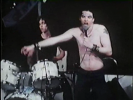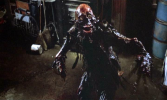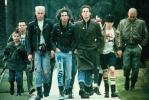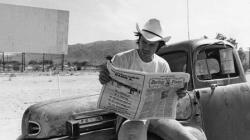Reviews
David Markey
USA, 1984
Credits
Review by Victoria Large
Posted on 19 September 2011
Source digital projection
Categories American Punk
Could this be the punkest movie ever made? Your answer to that question may vary depending on your definition of punk, and the HFA’s “American Punk” repertory series has included a host of worthy candidates. But if you believe that at its core, punk is about inexperienced kids with little or no training cranking out noisy, transgressive creations, than the spectacularly titled Desperate Teenage Lovedolls makes for a pretty strong contender for the punkest movie crown. Directed by David Markey before he reached the age of 21, the film was shot on Super 8 with a rumored budget of about $250 (the cost of purchasing and developing the film at Thrifty Drug, Sav-on, and Fotomat). In other words, Lovedolls is an incredibly amateurish effort. It also happens to be a complete hoot: a youthfully energetic, fearlessly ridiculous film that manages to critique rock movie clichés simply by replicating them so crudely.
The plot is typical cost-of-fame stuff: The Lovedolls are an all-girl rock group whose members will do anything to make it big. Their story is one of excess: sex, drugs, violence and rock and roll are the order of the day. But this is a rock flick with a difference. At times the film put me in mind of The Young Visiters, or, Mr. Salteena’s Plan, a short novel purportedly written by nine-year-old Daisy Ashford in 1890. The Young Visiters gained a following because for all its seeming artlessness, it actually provides a fairly pointed critique of the foolishness of adults. Lovedolls offers a similar kick: Markey has seen enough trashy showbiz flicks - The Valley of the Dolls is his biggest touchstone - to speak their language fluently, but he does so with tongue planted firmly in cheek, and the young cast and grungy production values heighten the comic effect.
The kids in the cast are clearly having a blast - it’s often evident that they’re fighting back laughter - and seeing them careen around southern California in bad wigs pretending to do bad things is a surreal and often hilarious experience. It’s true that the performers’ young ages coupled with the film’s frank vulgarity is occasionally uncomfortable (never more so than when the band’s sleazy manager, Johnny Tremain, forces himself on one of the girls in a carefully choreographed scene), but the film’s naïveté generally saves it from really offending. Indeed, there’s a sweetness to the whole affair, particularly when The Lovedolls are lip-synching and posturing their way through a performance of their hit song. The more mainstream Times Square may embody rock and roll-fueled teenage fantasies, but Lovedolls has the authenticity of teenagers taking control of the means of production and making their fantasies come true. It helps that the music for the film, including the theme tune performed by California pop punks Redd Kross, is lively and infectious, matching the high energy of the film itself.
Desperate Teenage Lovedolls plays well in front of a good-sized group of people who are able to get on the movie’s warped, cheerfully vulgar wavelength. The Harvard screening had that, with the added perversity of watching such a sordid production in the halls of one of the nation’s most prestigious universities serving only to enhance the experience. A living room full of likeminded friends should do the trick, though, with one-liners like “Thanks for killing my mom,” and, “I think I could do for you girls what God did for mankind,” eliciting laughs and lending themselves to future quotability.
Markey’s film played at the HFA on the same night as Border Radio, another punk-infused D.I.Y. production, and while the latter is considerably more technically accomplished, both films speak to the ingenuity and determination that is such an admirable attribute of both punk rock and independent film. The pairing made for a particularly uplifting double feature, a marvelous reminder that as much as punk can be about modern futility; it can also be about possibility.
More American Punk
-

Times Square
1980 -

D.O.A.: A Rite of Passage
1980 -

The Decline of Western Civilization
1981 -

The Return of the Living Dead
1985 -

Suburbia
1984 -

Border Radio
1987 -

Desperate Teenage Lovedolls
1984 -

The Blank Generation
1976
We don’t do comments anymore, but you may contact us here or find us on Twitter or Facebook.



